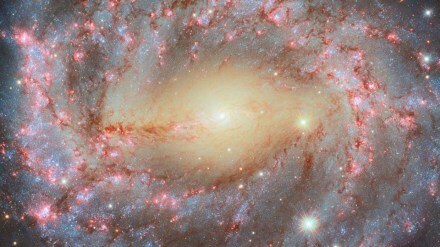A new image from NASA/ESA’s Hubble Space Telescope reveals the stunning spiral galaxy NGC 5643, located approximately 40 million light-years away in the constellation Lupus. This galaxy, known for its distinct symmetrical structure, showcases two prominent spiral arms filled with bright-blue stars, lacy reddish-brown dust clouds, and vibrant pink regions where new stars are forming.
While NGC 5643 is already a breathtaking sight in visible light, some of its most fascinating features remain hidden to the human eye. The galaxy harbors an active galactic nucleus (AGN), a particularly bright and energetic core powered by a supermassive black hole. This black hole pulls in gas from its surroundings, heating it up to extreme temperatures and causing it to emit brilliant X-rays. However, recent observations have revealed an unexpected discovery that challenges current understanding.
Researchers using ESA’s XMM-Newton telescope have found an even brighter X-ray source on the galaxy’s outskirts, known as NGC 5643 X-1. The source is likely a much smaller black hole, estimated to be around 30 times the mass of the Sun, outshining the galaxy’s central supermassive black hole. NGC 5643 X-1 is believed to be in an intense interaction with a companion star, pulling gas from the star and forming a superheated disk that emits an extraordinary amount of X-rays.
The discovery of this unusual black hole, located outside the galaxy’s central core, presents an intriguing puzzle for astronomers. The team continues to investigate the nature of this X-ray source and its potential implications for our understanding of black holes and galaxy formation.
This new Hubble image not only highlights the galaxy’s mesmerizing spiral arms but also incorporates additional wavelengths of light, revealing gas heated by young, massive stars. The findings provide a deeper understanding of the dynamic processes at play in one of the most well-studied galaxies in our cosmic neighborhood.
